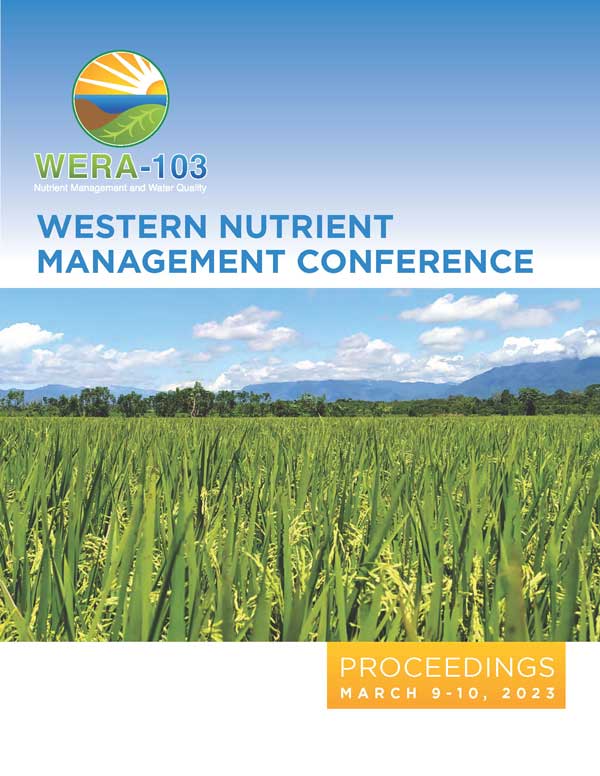Download the Conference Proceedings
Proceedings
Authors
| Filter results8 paper(s) found. |
|---|
1. Nitrogen Management in Small Grains After AlfalfaSmall grains are commonly grown following alfalfa in Utah and the Intermountain West, especially during drought years as small grains require less irrigation than corn. Several studies across the country have shown that corn following alfalfa rarely needs N fertilizer, yet relatively few have evaluated the N needs of small grains. Furthermore, research on the N needs of small grains grown as forage vs. grain are even more sparse. The objectives of this research are to quantify the... C. Pound, M. Yost, E. Creech, G. Cardon, K. Russell, D. Despain, J. Gale, K. Heaton, B. Kitchen, M. Pace, S. Price, C. Reid, M. Palmer, M. Nelson |
2. Effects of a One-time Compost Addition on Soil Health in a Rainfed Dryland Organic Wheat SystemMaintaining adequate soil fertility and health is a challenge in dryland organic wheat systems. This research examines the short-term impact of a one-time addition of compost on the soil health in a rainfed dryland organic winter-wheat (Triticum aestivum L.) fallow system. Field plot experiments were established in 2015 in a semiarid dryland organic wheat field in Snowville, Utah with the following treatments: control (C), compost at 12.5 Mg/ha dry weight (CM1), 25 Mg/ha (CM2), 50 Mg/ha... I. Atoloye, J. Reeve, A. Jacobson, E. Creech |
3. Effect of Cover Crops and Compost on Soil Water Availability in Organic Dryland WheatIn low input semi-arid regions, water is the major limiting factor in crop production. Cover crop biomass and compost are good source of organic matter, that improve biological activity and water holding capacity of soils. However, dryland organic wheat growers rarely apply soil amendments due to cost and cover crops can lead to the depletion of soil water which decreases the yield of subsequent winter wheat. This study investigates the potential for a synergy between compost addition and cover... K. Adeleke, J. Reeve, E. Creech, I. Atoloye |
4. Influence of Dairy Manure Applications on Corn Nutrient UptakeCorn silage is the predominant crop in Idaho used for recovering phosphorus (P) that has accumulated in soils from dairy manure applications. However, little is known about how much phosphorus and other nutrients are being recovered under Idaho conditions. The objective of the study is to estimate phosphorus removal by irrigated corn silage crops cultivated throughout Southern Idaho with variable soil test P concentrations, and to identify effects of increasing soil test P on potassium (K), calcium... A. Moore, B. Brown, J. Ippolito, S. Hines, M. De haro marti, C. Falen, M. Chahine, T. Fife, R. Norell |
5. Predicting Plant-available Nitrogen Release from Cover Crop ResiduesImproved methods are needed to estimate the timing and amount of plant- available N (PAN) release from cover crops. The OSU Organic Fertilizer and Cover Crop Calculator, a downloadable spreadsheet tool, assists agricultural professionals in estimating N fertilizer replacement value of organic inputs. We conducted a series of laboratory incubations with cover crop biomass incorporated into soil to determine: (i) speed of PAN release, (ii) amount of PAN release, and (iii) robustness of the OSU Calculator... D. Sullivan, N. Andrews, R. Datta, K. Pool |
6. Performance of Public and Private Fertilizer Recommendations for Corn, Alfalfa, and Small GrainsThere are many sources that growers utilize to determine fertilizer needs for crops such as private and public labs, crop advisors, and fertilizer dealers. In many cases, these sources provide recommendations for a specific crop that can vary greatly, and the resulting fertilizer and application rates recommended can lead to large differences in costs for the grower. Evaluating the effectiveness and economics of current fertilizer guidelines and recommendations will help growers to make better-informed... M. Yost, M. Baker, J. Gale, E. Creech, G. Cardon |
7. Evaluating Zinc Requirements of Corn, Small Grains, and AlfalfaMany growers and crop advisors in the Intermountain west have recently reported Zn deficiencies in major cereal and forage crops. Further, many common fertilizer blends now include Zn. Most Zn fertilizer guidelines indicate that 5-10 lbs of Zn per acre should be applied when critical soil test Zn levels are less than about 0.8 ppm Zn. These guidelines in Utah and many other states in the region were developed decades ago and need to be reassessed. Therefore, we established Zn response and rate... M. Yost, M. Baker, J. Gale, G. Cardon, E. Creech |
8. Nutrient Management for Semi-arid Cannabis ProductionThe industrial hemp (Cannabis sativa L.) industry rapidly emerged in Utah in 2019 with nearly 480 new hectares of hemp production. Production declined and stabilized during 2019-2022 due to low returns in a flooded pharmaceutical market. Though small and specialized, the hemp production industry is still viable in Utah and surrounding states. Many questions remain on optimal production practices for this new and potentially high-value crop. Research throughout the United States... T. Sullivan, M. Yost, D. Boren, E. Creech, B. Bugbee |
